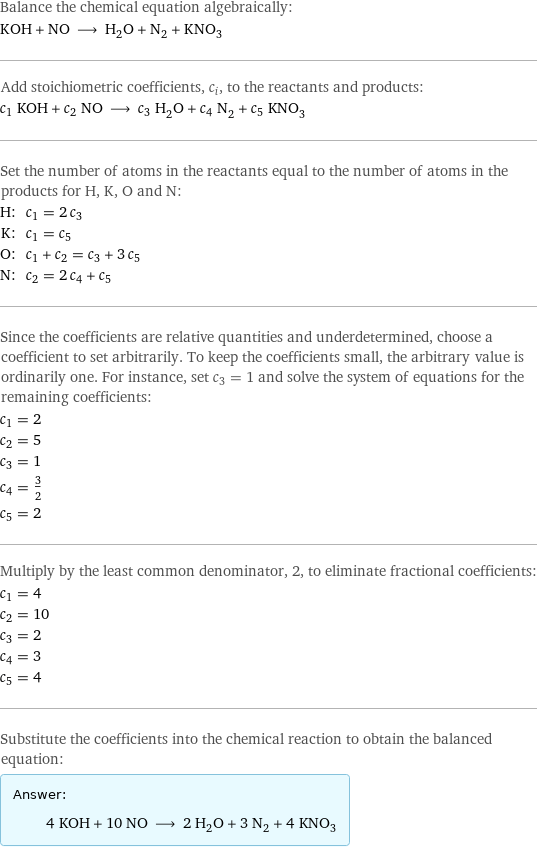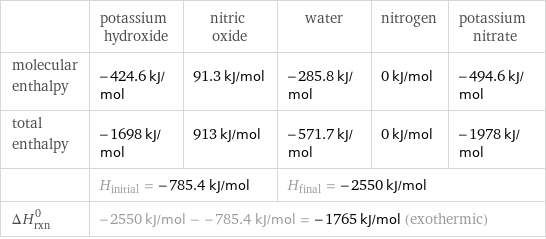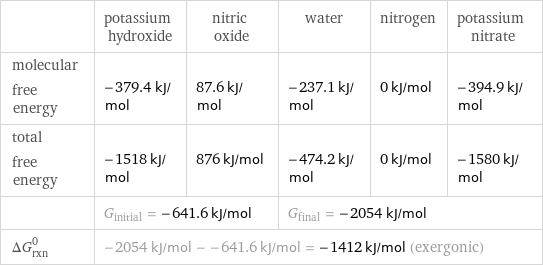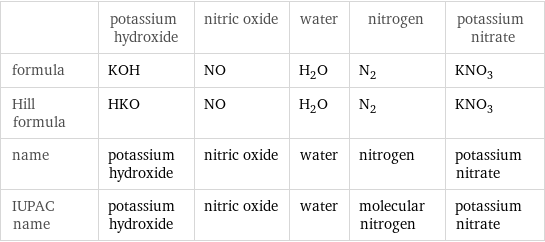Input interpretation

KOH potassium hydroxide + NO nitric oxide ⟶ H_2O water + N_2 nitrogen + KNO_3 potassium nitrate
Balanced equation

Balance the chemical equation algebraically: KOH + NO ⟶ H_2O + N_2 + KNO_3 Add stoichiometric coefficients, c_i, to the reactants and products: c_1 KOH + c_2 NO ⟶ c_3 H_2O + c_4 N_2 + c_5 KNO_3 Set the number of atoms in the reactants equal to the number of atoms in the products for H, K, O and N: H: | c_1 = 2 c_3 K: | c_1 = c_5 O: | c_1 + c_2 = c_3 + 3 c_5 N: | c_2 = 2 c_4 + c_5 Since the coefficients are relative quantities and underdetermined, choose a coefficient to set arbitrarily. To keep the coefficients small, the arbitrary value is ordinarily one. For instance, set c_3 = 1 and solve the system of equations for the remaining coefficients: c_1 = 2 c_2 = 5 c_3 = 1 c_4 = 3/2 c_5 = 2 Multiply by the least common denominator, 2, to eliminate fractional coefficients: c_1 = 4 c_2 = 10 c_3 = 2 c_4 = 3 c_5 = 4 Substitute the coefficients into the chemical reaction to obtain the balanced equation: Answer: | | 4 KOH + 10 NO ⟶ 2 H_2O + 3 N_2 + 4 KNO_3
Structures

+ ⟶ + +
Names

potassium hydroxide + nitric oxide ⟶ water + nitrogen + potassium nitrate
Reaction thermodynamics
Enthalpy

| potassium hydroxide | nitric oxide | water | nitrogen | potassium nitrate molecular enthalpy | -424.6 kJ/mol | 91.3 kJ/mol | -285.8 kJ/mol | 0 kJ/mol | -494.6 kJ/mol total enthalpy | -1698 kJ/mol | 913 kJ/mol | -571.7 kJ/mol | 0 kJ/mol | -1978 kJ/mol | H_initial = -785.4 kJ/mol | | H_final = -2550 kJ/mol | | ΔH_rxn^0 | -2550 kJ/mol - -785.4 kJ/mol = -1765 kJ/mol (exothermic) | | | |
Gibbs free energy

| potassium hydroxide | nitric oxide | water | nitrogen | potassium nitrate molecular free energy | -379.4 kJ/mol | 87.6 kJ/mol | -237.1 kJ/mol | 0 kJ/mol | -394.9 kJ/mol total free energy | -1518 kJ/mol | 876 kJ/mol | -474.2 kJ/mol | 0 kJ/mol | -1580 kJ/mol | G_initial = -641.6 kJ/mol | | G_final = -2054 kJ/mol | | ΔG_rxn^0 | -2054 kJ/mol - -641.6 kJ/mol = -1412 kJ/mol (exergonic) | | | |
Equilibrium constant
![Construct the equilibrium constant, K, expression for: KOH + NO ⟶ H_2O + N_2 + KNO_3 Plan: • Balance the chemical equation. • Determine the stoichiometric numbers. • Assemble the activity expression for each chemical species. • Use the activity expressions to build the equilibrium constant expression. Write the balanced chemical equation: 4 KOH + 10 NO ⟶ 2 H_2O + 3 N_2 + 4 KNO_3 Assign stoichiometric numbers, ν_i, using the stoichiometric coefficients, c_i, from the balanced chemical equation in the following manner: ν_i = -c_i for reactants and ν_i = c_i for products: chemical species | c_i | ν_i KOH | 4 | -4 NO | 10 | -10 H_2O | 2 | 2 N_2 | 3 | 3 KNO_3 | 4 | 4 Assemble the activity expressions accounting for the state of matter and ν_i: chemical species | c_i | ν_i | activity expression KOH | 4 | -4 | ([KOH])^(-4) NO | 10 | -10 | ([NO])^(-10) H_2O | 2 | 2 | ([H2O])^2 N_2 | 3 | 3 | ([N2])^3 KNO_3 | 4 | 4 | ([KNO3])^4 The equilibrium constant symbol in the concentration basis is: K_c Mulitply the activity expressions to arrive at the K_c expression: Answer: | | K_c = ([KOH])^(-4) ([NO])^(-10) ([H2O])^2 ([N2])^3 ([KNO3])^4 = (([H2O])^2 ([N2])^3 ([KNO3])^4)/(([KOH])^4 ([NO])^10)](../image_source/8b2704292a40431b715fa67c4f0279c7.png)
Construct the equilibrium constant, K, expression for: KOH + NO ⟶ H_2O + N_2 + KNO_3 Plan: • Balance the chemical equation. • Determine the stoichiometric numbers. • Assemble the activity expression for each chemical species. • Use the activity expressions to build the equilibrium constant expression. Write the balanced chemical equation: 4 KOH + 10 NO ⟶ 2 H_2O + 3 N_2 + 4 KNO_3 Assign stoichiometric numbers, ν_i, using the stoichiometric coefficients, c_i, from the balanced chemical equation in the following manner: ν_i = -c_i for reactants and ν_i = c_i for products: chemical species | c_i | ν_i KOH | 4 | -4 NO | 10 | -10 H_2O | 2 | 2 N_2 | 3 | 3 KNO_3 | 4 | 4 Assemble the activity expressions accounting for the state of matter and ν_i: chemical species | c_i | ν_i | activity expression KOH | 4 | -4 | ([KOH])^(-4) NO | 10 | -10 | ([NO])^(-10) H_2O | 2 | 2 | ([H2O])^2 N_2 | 3 | 3 | ([N2])^3 KNO_3 | 4 | 4 | ([KNO3])^4 The equilibrium constant symbol in the concentration basis is: K_c Mulitply the activity expressions to arrive at the K_c expression: Answer: | | K_c = ([KOH])^(-4) ([NO])^(-10) ([H2O])^2 ([N2])^3 ([KNO3])^4 = (([H2O])^2 ([N2])^3 ([KNO3])^4)/(([KOH])^4 ([NO])^10)
Rate of reaction
![Construct the rate of reaction expression for: KOH + NO ⟶ H_2O + N_2 + KNO_3 Plan: • Balance the chemical equation. • Determine the stoichiometric numbers. • Assemble the rate term for each chemical species. • Write the rate of reaction expression. Write the balanced chemical equation: 4 KOH + 10 NO ⟶ 2 H_2O + 3 N_2 + 4 KNO_3 Assign stoichiometric numbers, ν_i, using the stoichiometric coefficients, c_i, from the balanced chemical equation in the following manner: ν_i = -c_i for reactants and ν_i = c_i for products: chemical species | c_i | ν_i KOH | 4 | -4 NO | 10 | -10 H_2O | 2 | 2 N_2 | 3 | 3 KNO_3 | 4 | 4 The rate term for each chemical species, B_i, is 1/ν_i(Δ[B_i])/(Δt) where [B_i] is the amount concentration and t is time: chemical species | c_i | ν_i | rate term KOH | 4 | -4 | -1/4 (Δ[KOH])/(Δt) NO | 10 | -10 | -1/10 (Δ[NO])/(Δt) H_2O | 2 | 2 | 1/2 (Δ[H2O])/(Δt) N_2 | 3 | 3 | 1/3 (Δ[N2])/(Δt) KNO_3 | 4 | 4 | 1/4 (Δ[KNO3])/(Δt) (for infinitesimal rate of change, replace Δ with d) Set the rate terms equal to each other to arrive at the rate expression: Answer: | | rate = -1/4 (Δ[KOH])/(Δt) = -1/10 (Δ[NO])/(Δt) = 1/2 (Δ[H2O])/(Δt) = 1/3 (Δ[N2])/(Δt) = 1/4 (Δ[KNO3])/(Δt) (assuming constant volume and no accumulation of intermediates or side products)](../image_source/a9b9897b806a7ae702a9503c9a722964.png)
Construct the rate of reaction expression for: KOH + NO ⟶ H_2O + N_2 + KNO_3 Plan: • Balance the chemical equation. • Determine the stoichiometric numbers. • Assemble the rate term for each chemical species. • Write the rate of reaction expression. Write the balanced chemical equation: 4 KOH + 10 NO ⟶ 2 H_2O + 3 N_2 + 4 KNO_3 Assign stoichiometric numbers, ν_i, using the stoichiometric coefficients, c_i, from the balanced chemical equation in the following manner: ν_i = -c_i for reactants and ν_i = c_i for products: chemical species | c_i | ν_i KOH | 4 | -4 NO | 10 | -10 H_2O | 2 | 2 N_2 | 3 | 3 KNO_3 | 4 | 4 The rate term for each chemical species, B_i, is 1/ν_i(Δ[B_i])/(Δt) where [B_i] is the amount concentration and t is time: chemical species | c_i | ν_i | rate term KOH | 4 | -4 | -1/4 (Δ[KOH])/(Δt) NO | 10 | -10 | -1/10 (Δ[NO])/(Δt) H_2O | 2 | 2 | 1/2 (Δ[H2O])/(Δt) N_2 | 3 | 3 | 1/3 (Δ[N2])/(Δt) KNO_3 | 4 | 4 | 1/4 (Δ[KNO3])/(Δt) (for infinitesimal rate of change, replace Δ with d) Set the rate terms equal to each other to arrive at the rate expression: Answer: | | rate = -1/4 (Δ[KOH])/(Δt) = -1/10 (Δ[NO])/(Δt) = 1/2 (Δ[H2O])/(Δt) = 1/3 (Δ[N2])/(Δt) = 1/4 (Δ[KNO3])/(Δt) (assuming constant volume and no accumulation of intermediates or side products)
Chemical names and formulas

| potassium hydroxide | nitric oxide | water | nitrogen | potassium nitrate formula | KOH | NO | H_2O | N_2 | KNO_3 Hill formula | HKO | NO | H_2O | N_2 | KNO_3 name | potassium hydroxide | nitric oxide | water | nitrogen | potassium nitrate IUPAC name | potassium hydroxide | nitric oxide | water | molecular nitrogen | potassium nitrate